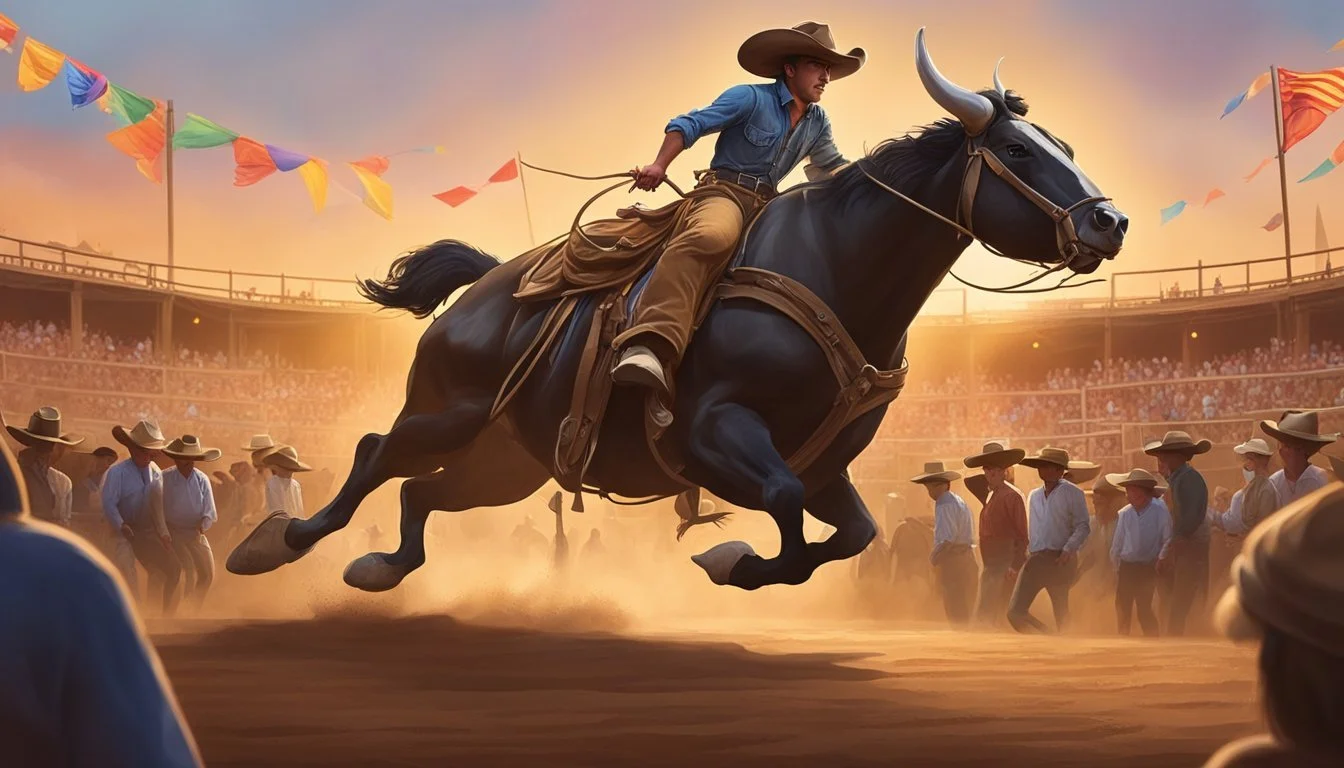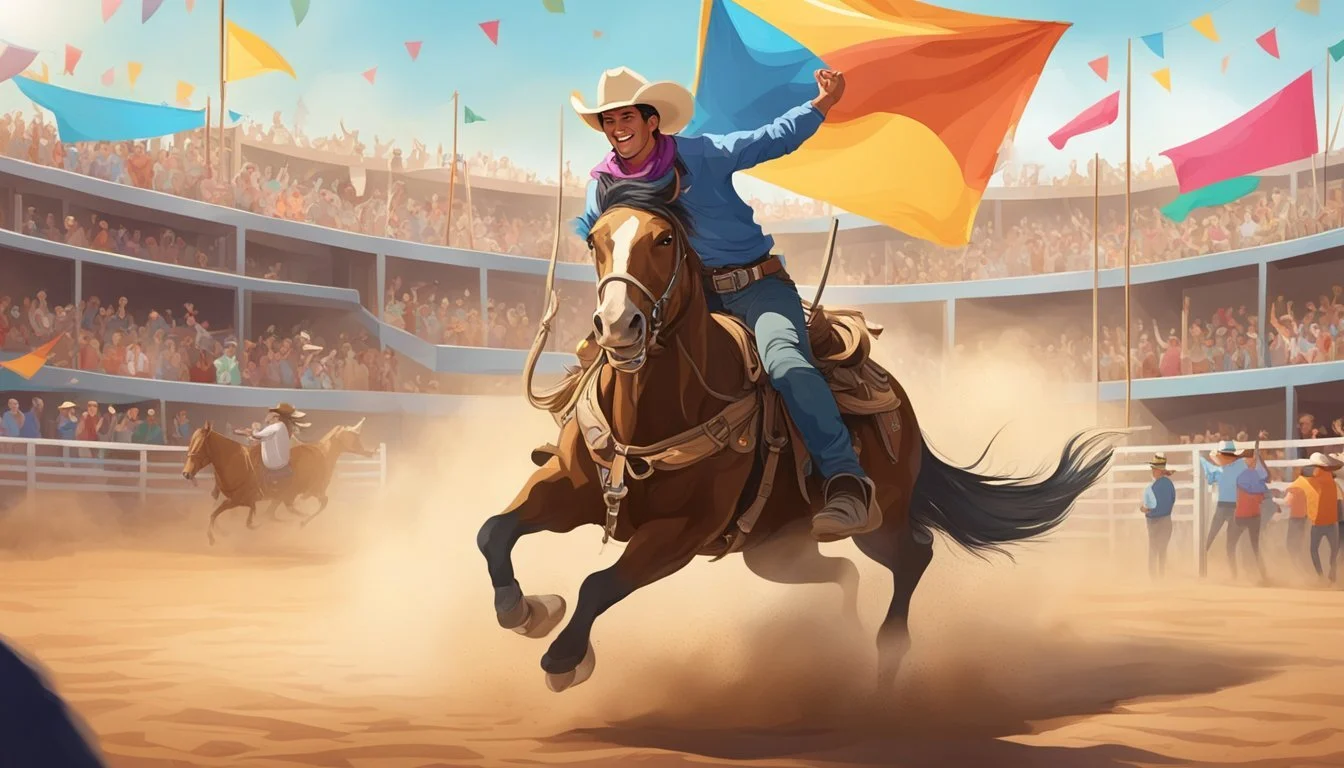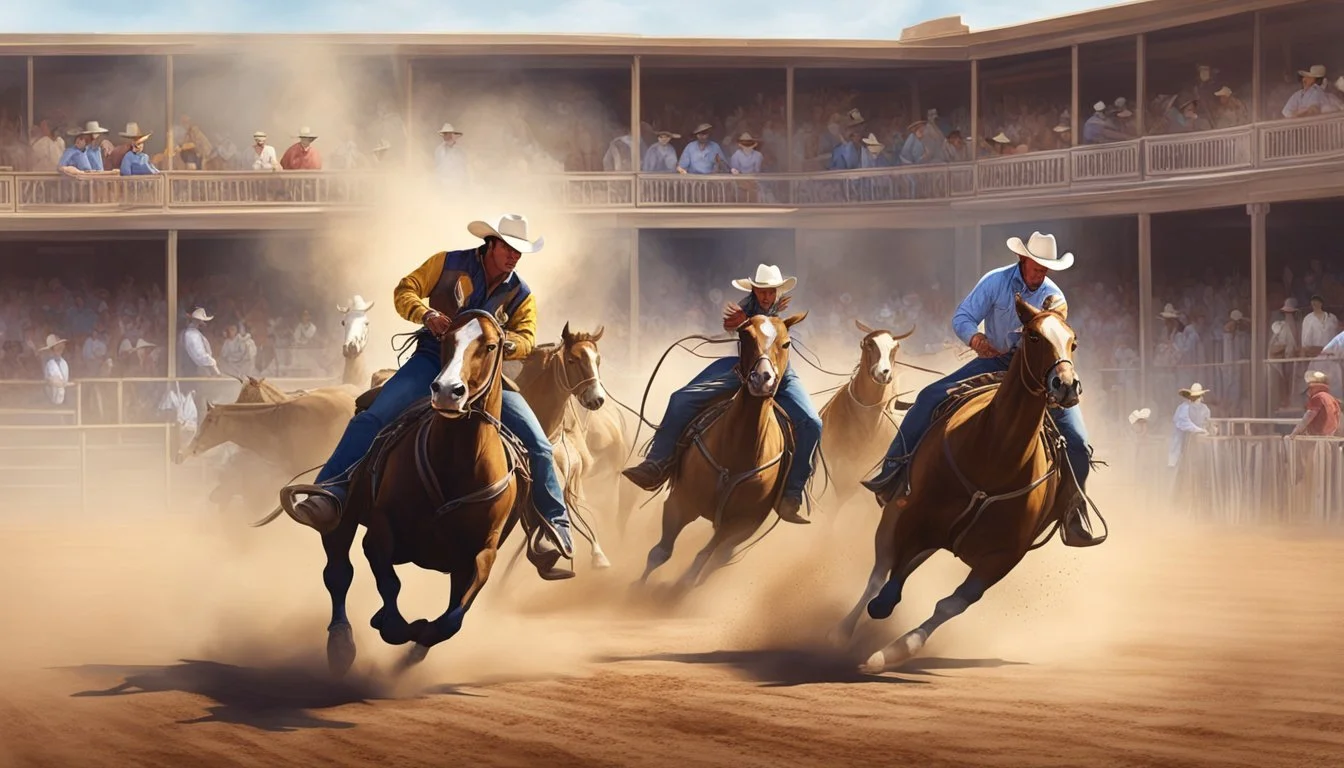The Texas Cowboy's Passion for Rodeo
Spotlight on Top State Contests
The Texas cowboy's passion for rodeo is an enduring symbol of the state's rich cultural heritage. With its roots deeply planted in the Spanish vaquero traditions of skilled horsemanship and cattle herding, Texas rodeos have become a celebrated cornerstone of the Lone Star State's identity. These competitions are no mere pastimes; they're a testament to the skill, dedication, and courage of the cowboys and cowgirls who partake in heart-pounding events that range from bull riding to steer wrestling.
Rodeo events in Texas draw massive crowds, eager to witness the grit and grace of western athletes in action. Iconic venues like the Travis County Expo Center in Austin and the Foster Communications Coliseum in San Angelo become bustling hubs of energy during rodeo season. The San Angelo Stock Show & Rodeo, for example, is not just an event but a tradition, encapsulating the essence of Western heritage in a welcoming atmosphere. Here, the community's support converges with the competitive spirit of rodeo to offer a memorable experience for spectators and participants alike.
Texas is also home to celebrations that honor the diversity within cowboy culture, recognizing the contributions of Black and Latino cowboys to the rodeo scene. Events such as the Cowboys of Color Rodeo reflect a broader American heritage and celebrate the unique blend of cultures that contribute to the state's storied history. Together, these events showcase the Lone Star state's unwavering commitment to preserving the legacy of the Texas cowboy and the thrilling sport of rodeo.
History of Rodeo in Texas
From the dusty trails to the roaring crowds of the arena, the history of rodeo in Texas encapsulates the state's cowboy heritage and the transformation of local competitions into a revered professional sport.
Early Origins and Influence
The very essence of the Texas rodeo has its roots in the diverse cultures that shaped the early American West. Spanish influence was particularly significant, with the "vaqueros" – skilled horsemen and cattle herders – laying the groundwork for what would become a deep-seated cowboy tradition. These original cowboys set the standard for expert horsemanship and cattle handling, which were vital skills in the sprawling ranches of Texas.
The traditions and techniques of Mexican, Native American, and Spanish cultures all blended together, influencing the practices of the American cowboy. This melange of traditions helped forge a unique Texan identity within the cowboy culture, which reverberated throughout the Old West and continues to be celebrated in modern rodeo events.
Evolution Into a Professional Sport
In 1883, Pecos, Texas, claimed the spotlight by hosting what is often cited as the first public rodeo event. This gathering was sparked by a competitive spirit between a cattle roper and a cattle driver, evolving into a spectacle that attracted spectators and participants alike. Such events were forerunners to the rodeos that would become a significant part of both local festivity and national entertainment.
By 1918, the professional aspect of rodeo took a grand leap forward when Fort Worth hosted the first indoor rodeo at the historic Cowtown Coliseum. Not long after, in 1932, this venue also became the first to have rodeo broadcasts live on radio, expanding its reach beyond the confines of Texas. As rodeos increased both in popularity and in professional organization, they began to incorporate a variety of events, such as bull riding, calf roping, and steer roping, which highlighted the diverse skill set of the cowboy competitors. Texas has been home to some of the largest prize pots in rodeo, with three of its rodeos making the top list in 1990, indicating the competitive nature and prestige of the state's rodeo circuit.
Iconic Texas Rodeo Events
In Texas, rodeos are not just competitions; they form a significant part of the cultural tapestry and popular culture. Here are some of the most celebrated Texas rodeo events that encapsulate the spirit of the rodeo season throughout the state.
Houston Livestock Show and Rodeo
Houston, Texas sets the stage for the Houston Livestock Show and Rodeo, the largest event of its kind globally. Drawing over two million visitors annually, the event promises a blend of entertainment, livestock exhibitions, and thrilling rodeo action each year, traditionally taking place from late February to mid-March.
Fort Worth Stock Show and Rodeo
Situated in one of the original stockyards, the Fort Worth Stock Show and Rodeo is a true Texas heritage event. Fort Worth honors the essence of cowboy culture, hosting one of the oldest livestock shows and rodeos, which features a rich schedule of competitions, exhibitions, and educational events.
San Antonio Stock Show and Rodeo
San Antonio is recognized for hosting an 18-day-long spectacle, the San Antonio Stock Show and Rodeo. Having received accolades for its size and quality, this rodeo is renowned for its significant contribution to the educational support of Texas youth, illustrating the blend of tradition and philanthropy.
Rodeo Austin
March in Austin, Texas, marks the arrival of Rodeo Austin, a celebration that goes beyond the rodeo arena. This rodeo combines competitive events, a stock show, and fair attractions, spotlighting Austin's dedication to preserving the heritage of the Texas cowboy while also providing scholarships for education.
West of the Pecos Rodeo
Dating back to 1883, the West of the Pecos Rodeo held in Pecos, Texas, prides itself on being one of the oldest rodeos. Professional contestants often cite the rugged charm of this outdoor event as a highlight of their rodeo careers, underlining it as a stalwart in the rodeo calendar.
Stockyards Championship Rodeo
The Stockyards Championship Rodeo in Fort Worth emphasizes the city's deep-rooted connection with the cowboy legacy. Weekly rodeos allow this event to be a consistent representation of Texas's competitive rodeo spirit, offering a year-round attraction for fans and participants alike.
Mesquite Championship Rodeo
In Mesquite, Texas, the Mesquite Championship Rodeo showcases seasoned talent and rising stars in the rodeo world. This event has carved out its place within Texas's rodeo scene as a summer staple, celebrating the past and present of the rodeo craft and nurturing a shared cultural experience.
The Life of a Texas Cowboy
In Texas, the cowboy is not just a figure from the past, but a living, breathing part of the state's culture. From the historic cattle drives to the intense competition of modern rodeos, they embody resilience and a deep-rooted heritage.
Cattle Drives and Ranching Heritage
The heyday of cattle drives in Texas dates back to the mid-1800s, when the demand for beef in the Northeast fueled the growth of the cattle industry. Ranches such as the King Ranch, a beacon in the state's ranching history, became integral networks to the industry's development. Cowboys would herd thousands of cattle across vast distances, enduring harsh conditions and danger, asserting Texas as the Lone Star State of the cowboy.
Ranches: King Ranch and others as cornerstones of the cowboy profession
Cattle Drive: Crucial for the movement and sale of cattle; a historical backbone of the industry
Rodeo Athletes' Grit and Resilience
Cowboys translate their skills from working on ranches to competing in rodeos, displaying remarkable resilience and expertise. These athletes participate in events that test their proficiency in riding, roping, and other disciplines developed from cattle drive duties. Rodeos have evolved into a competitive arena where cowboys aim for top honors, underscoring their dedication and grit in the face of challenge.
Rodeo: A competitive showcase of traditional cowboy skills
Resilience: Physical and mental toughness exhibited by rodeo competitors
Women in Rodeo: The Texas Cowgirls
Texas cowgirls have a prominent place in rodeo history, reflecting an enduring legacy of strong women in the sport. They are celebrated members of the community, with some enshrined in the National Cowgirl Hall of Fame. Displaying skills equivalent to their male counterparts, these cowgirls shatter stereotypes and prove that the heart of Texas rodeo does not distinguish between genders.
Cowgirls: Mark their excellence and prowess in rodeo
National Cowgirl Hall of Fame: An institution that honors women's contributions to the cowboy culture
Texas cowboys and cowgirls contribute to keeping the state's storied cowboy life vibrant, weaving the past and present into a tapestry that reflects the spirit of the Lone Star State.
Rodeo Competitions and Their Significance
Rodeo competitions are a vibrant display of tradition and skill that pay homage to the cowboys’ rich heritage. With adrenaline-pumping action and skillful displays, these events tap into the heart of Texas culture.
The Thrill of Bull Riding
Bull riding is arguably the most iconic and dangerous rodeo event. Competitors must stay atop a bucking bull for eight seconds, with only a rope tied around the animal as support. The rider's grip and balance are critical in this high-stakes event, where the risk is as high as the adrenaline surges that thrill both participants and spectators alike.
Precision in Team Roping and Calf Roping
Team roping requires two riders, a header, and a heeler, to capture a steer with flawless coordination. The header lassos the steer's horns, then the heeler targets the hind legs. Calf roping, on the other hand, demands a single cowboy to chase, rope, and immobilize a calf, exhibiting both speed and precision.
Header: Ensures the steer is correctly captured by the horns
Heeler: Completes the process by lassoing the steer's hind legs
Agility and Speed in Barrel Racing
Barrel racing showcases the rider's horsemanship skills along with the horse's agility and speed. Contestants navigate a cloverleaf pattern around preset barrels in the quickest time possible, with each turn signifying the fine line between speed and precision.
First Barrel: Tests the immediate acceleration and cornering
Second and Third Barrels: Challenge the rider's control and the horse's agility
The Challenge of Steer Wrestling
In steer wrestling, the contestant, also known as a "bulldogger," must leap from their horse onto a steer and wrestle it to the ground by twisting its horns. This event is a testament to sheer strength and technique, with precise timing crucial to successfully topple the steer.
Horse: Trained to run beside the steer for positioning
Bulldogger: Executes the leap and twist to bring the steer down
Each rodeo event celebrates different aspects of the cowboy's role and the legacy of the Texas frontier spirit. From the strength required in steer wrestling to the dynamic precision in roping competitions and the intense rush of bull riding, these competitions remain an enduring staple of Texas culture.
Rodeo Culture and Community
Texas rodeo culture is a vibrant tapestry that weaves together community spirit, livestock expertise, and the youthful energy of its competitors. It invigorates local economies, fosters pride, and preserves the cowboy heritage.
Local Celebrations and Small Town Competitions
Small towns across Texas brim with local pride during rodeo season. Communities come alive as they host events that showcase the skills and traditions of rodeo culture. For many towns, the rodeo is the highlight of the year, bringing together families, neighbors, and visitors to celebrate their shared heritage and passion for the sport. Local celebrations are not just competitions but social hubs that strengthen community bonds.
Key Features of Small Town Rodeos:
Ample participation from local residents
Boost to local businesses and tourism
Exhibitions of rodeo traditions and novelties
Role of Livestock and Clowns
Livestock are at the heart of every rodeo, with bulls and horses being central to events like bull riding, bronc riding, and team roping. They are more than just animals; they are athletes, revered for their strength and agility. Rodeo clowns, on the other hand, play a critical role in ensuring the safety of riders, often at great personal risk. Their antics provide entertainment but, more importantly, they distract bulls to protect cowboys and cowgirls following a dismount.
Vital Contributions:
Livestock: Carefully bred and trained for peak performance
Clowns: Safety professionals and entertainers
Popularity Amongst Young Men and Women
The appeal of rodeos extends to the youth of Texas, drawing young men and women to partake in this storied tradition. They step into the arena not only for the thrill and competition but also to carry forward a way of life that defines their culture. The Professional Rodeo Cowboys Association (PRCA) and regional associations play key roles in organizing events that foster the growth of youth participation in rodeo, ensuring its future and nurturing the next generation of skilled cowboys and cowgirls.
Aspects Influencing Youth Participation:
The allure of competition and personal achievement
Community support and mentorship
Opportunities for professional advancement within PRCA-sanctioned events
The Sport's Economic and Cultural Impact
Rodeos in Texas are not just a sport but a significant contributor to the state's economy and an embodiment of its rich cultural heritage. They reflect the traditions of the American Southwest and uphold the legacy of Texas culture.
Rodeo's Contribution to the Local Economy
The economic impact of rodeos in Texas is substantial. These events draw competitors and spectators from across America, generating revenue through ticket sales, lodging, and local retail. For instance, it is reported that Texas hosts numerous rodeo events throughout the year, providing a consistent financial boost to various communities. In addition to the direct spending, rodeos often support local businesses, from equipment suppliers to restaurants, contributing to job creation and economic diversity.
Direct Economic Activities: Ticket sales, participant fees, sponsorships.
Indirect Support: Increased demand for local hospitality and retail services.
Job Creation: Seasonal and permanent jobs in event management, hospitality, and more.
Rodeo as a Reflection of Texas Heritage
Rodeo is deeply rooted in Texas heritage and reflects the state's identity. These events are living exhibitions of the cowboy lifestyle, showcasing skills derived from the historical cattle-herding practices. They honor the vaqueros, the original cowboys, and their horsemanship, which have been central to Texas culture since the Spanish influence. Rodeos serve to educate both residents and visitors on the state's rich history, keeping the spirit of the Southwest's past alive.
Cultural Significance: Preservation and demonstration of traditional cowboy skills.
Educational Value: Rodeos as platforms for sharing Texas's ranching history.
Identity Marker: Rodeos symbolize the enduring image of the American cowboy.
Education and Preservation of Rodeo History
The Texas rodeo has a rich heritage that is preserved and taught through various institutions and programs. These efforts ensure that the tradition of rodeo, and the skills associated with riding and competition, remain an enduring part of the state's culture.
Museums and Historical Societies
Texas Rodeo Cowboy Hall of Fame, based in the Cowtown Coliseum of the Historic Fort Worth Stockyards, serves as a central repository of the state's rodeo history. Here, one can find an extensive collection that comprises over 390 pictures and biographies that pay homage to rodeo personalities’ achievements and contributions to the sport. This organization emphasizes education by sharing the stories of past champions and preserving rodeo artifacts.
Another institution, the National Cowboy & Western Heritage Museum in Oklahoma City, albeit not in Texas, also plays a significant role in preserving the rodeo legacy and offers educational resources that contribute to understanding the historical importance of rodeo tradition.
Event Memorabilia and Endorsements
Collecting and showcasing event memorabilia has become a part of the educational narrative. Commemorative items such as boots, hats, saddles, and buckles offer a tangible connection to rodeo history. These items often carry endorsements from celebrated rodeo participants and are displayed in museums and at rodeo events, bridging the gap between past and present traditions.
Endorsements by renowned rodeo athletes also play a role in raising awareness and generating support for preserving the culture and history of the sport. Their involvement can lend significant credibility to educational initiatives and heritage sites.
Rodeo Education Programs
Several rodeo education programs exist to teach the next generation of enthusiasts about the sport's heritage and techniques. These programs can range from academic curricula provided by institutions such as Tarleton State University in Stephenville, Texas, to youth organizations like 4-H or Future Farmers of America (FFA), which include rodeo and riding activities in their programming.
Rodeo clinics and seminars conducted by professional riders offer hands-on experiences and are instrumental in passing down skills and fostering a deep appreciation for the sport's history and traditions. These programs ensure that the legacy of Texas rodeo continues and remains relevant to budding cowboys and cowgirls.







